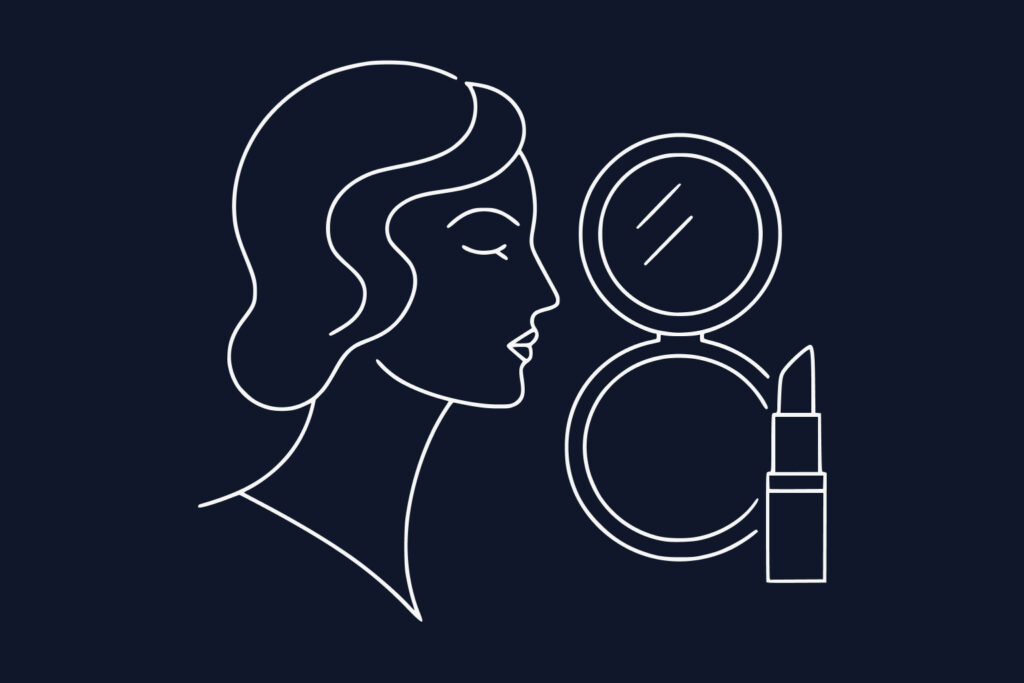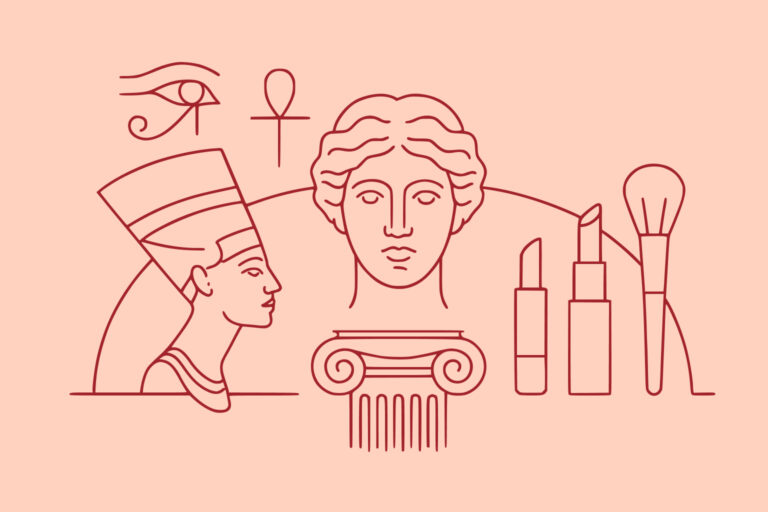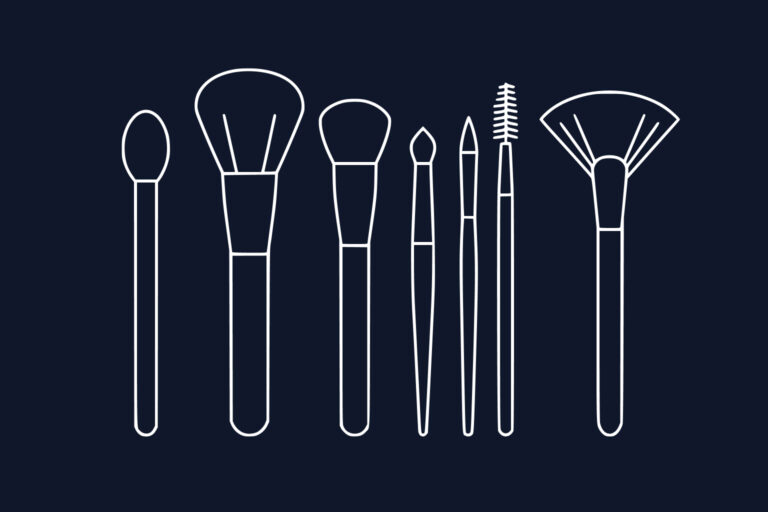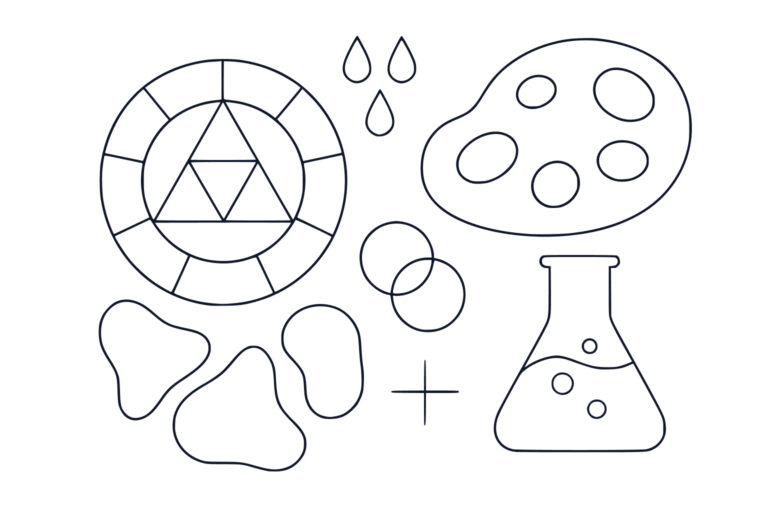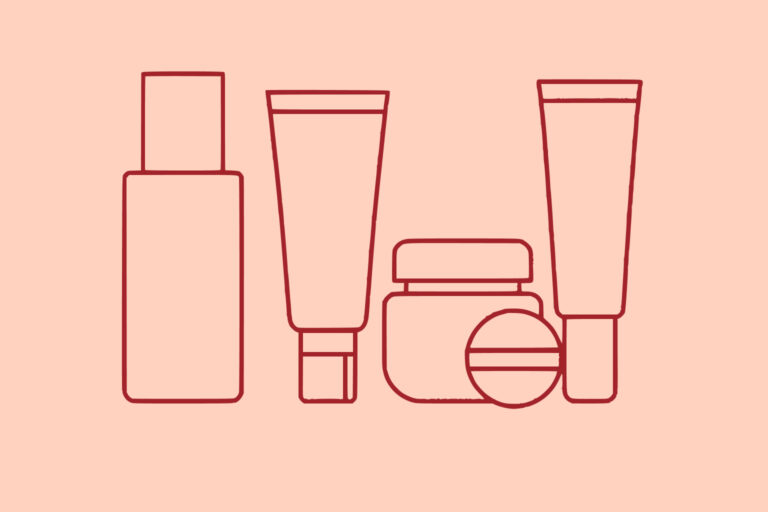Post-War Beauty and the New Look Era: 1940s-1950s Makeup and Hairstyles
Published by Professional Makeup Artist London
The period from 1940 to 1955 marked one of the most transformative eras in beauty history, shaped by wartime necessity, post-war optimism, and Christian Dior’s revolutionary New Look. This era witnessed the evolution from practical wartime beauty to the ultra-feminine glamour that defined the 1950s. Women’s makeup and hairstyles during this period reflected broader social changes, from wartime rationing and women’s workforce participation to the post-war return to domesticity and luxury. Understanding this pivotal period reveals how external circumstances can dramatically influence beauty standards and practices.
Wartime Beauty: 1940-1945
The early 1940s established beauty practices that balanced practicality with morale-boosting glamour. Government campaigns encouraged women to maintain their appearance as a patriotic duty, leading to the famous slogan “Beauty is your duty” which appeared in British and American propaganda.
Makeup during wartime faced significant challenges due to rationing and material shortages. Lipstick became a symbol of resistance and normalcy, with governments ensuring continued production despite material constraints. The iconic “Victory Red” shade emerged as the most popular colour, representing both patriotism and feminine strength. Women learned to make lipstick last longer by applying it in thin layers and using Vaseline to add gloss to matte formulations.
Foundation and powder were scarce, leading to innovative substitutions. Women used cold cream mixed with face powder to create makeshift foundation, whilst beetroot juice served as emergency rouge. Eyebrow pencils were sharpened with razor blades to extend their life, and mascara was applied with heated pins when commercial products weren’t available.
Eye makeup remained relatively simple due to product shortages. Women focused on well-groomed eyebrows, which were kept fuller than in previous decades, and used whatever dark pigments were available to define their lashes. Eyeshadow was minimal, often just a light application of powder or cream to even out the eyelid tone.
The wartime emphasis on practical makeup products led to innovations in long-wearing formulations and multi-purpose cosmetics that would influence post-war product development.
Victory Rolls and Wartime Hairstyles
Hairstyles of the 1940s were defined by practicality and patriotic symbolism. The victory roll became the era’s most iconic style, featuring rolled sections of hair at the front and sides of the head that kept hair away from the face and machinery whilst maintaining feminine appeal.
Victory rolls were created by sectioning the front hair, backcombing for volume, then rolling the hair over the fingers or a brush handle to create smooth, rounded shapes. These rolls were secured with bobby pins and set with whatever styling products were available, often homemade sugar water or beer.
Working women adopted shorter, more manageable styles that could be covered with headscarves or factory caps. The “Rosie the Riveter” look combined practicality with style, featuring hair rolled away from the face and secured at the nape of the neck.
Hair accessories became crucial during wartime due to product shortages. Headscarves, snoods, and hair nets served both practical and decorative purposes. Women learned to create elaborate styles using minimal products, relying on techniques like pin curls and finger waves that required only water and bobby pins.
Colour treatments were limited during wartime, with many women relying on natural methods like lemon juice for highlights or henna for red tones. Professional salon visits became luxury items, leading to increased home hair care and styling.
The New Look Revolution: 1947-1950
Christian Dior’s New Look, launched in February 1947, revolutionised not only fashion but also beauty standards. The ultra-feminine silhouette demanded corresponding changes in makeup and hairstyles that emphasised traditional femininity after years of wartime practicality.
The New Look’s emphasis on curves and femininity influenced makeup trends towards softer, more romantic looks. Foundation became more important as women sought flawless complexions to complement the polished New Look aesthetic. Post-war prosperity allowed for better cosmetic formulations and increased product availability.
Lipstick colours evolved from the bold reds of wartime to include softer pinks and corals that complemented the New Look’s romantic femininity. The application became more precise, with women using lip brushes to create perfect cupid’s bow shapes that enhanced the era’s emphasis on feminine perfection.
Eye makeup remained relatively subtle but became more refined. Eyebrows were shaped into elegant arches that complemented the New Look’s sophisticated aesthetic. Eyeshadow was used sparingly, typically in neutral tones that enhanced rather than competed with the elaborate fashions.
The New Look’s influence on beauty extended beyond specific products to encompass an entire approach to feminine presentation. Women spent more time on their appearance, viewing beauty routines as essential to achieving the polished, ladylike image that the New Look represented.
Understanding how fashion movements influence beauty trends provides valuable context for modern colour theory and makeup application decisions.
New Look Hairstyles
The New Look demanded hairstyles that complemented its ultra-feminine aesthetic. Hair became softer and more voluminous, moving away from the structured victory rolls towards styles that emphasised natural texture and movement.
The “New Look bob” featured chin-length hair with soft waves and side-swept bangs that framed the face elegantly. This style required regular salon maintenance and professional styling, reflecting the era’s return to leisure-class beauty ideals.
Longer hairstyles gained popularity as women embraced more traditionally feminine looks. Hair was often worn in soft rolls at the nape of the neck or styled in loose waves that cascaded over the shoulders. These styles required significant time and skill to achieve, often necessitating professional salon services.
Hair accessories evolved to complement the New Look’s sophisticated aesthetic. Elegant combs, decorative pins, and small hats became popular accessories that added refinement to hairstyles without overwhelming the overall look.
Colour treatments became more sophisticated as the beauty industry recovered from wartime shortages. Professional colouring services offered subtle highlights and lowlights that added dimension to hairstyles whilst maintaining natural-looking results.
1950s Perfection: The Golden Age of Glamour
The 1950s represented the culmination of post-war beauty trends, establishing standards of feminine perfection that would influence beauty culture for decades. This period saw the refinement of techniques and products that had emerged during the previous decade.
Foundation technology advanced significantly during the 1950s, with new formulations offering better coverage and longer wear. The decade’s emphasis on flawless complexions led to sophisticated application techniques that created porcelain-perfect skin. Women learned to use multiple products—primer, foundation, concealer, and powder—to achieve the flawless base that defined 1950s beauty.
Lipstick reached new heights of sophistication during the 1950s, with expanded colour ranges and improved formulations. The decade’s signature look featured perfectly applied red or pink lips with precise edges and smooth, even coverage. Lip liner became essential for achieving the precise application that 1950s beauty demanded.
Eye makeup evolved towards more dramatic effects whilst maintaining the era’s emphasis on feminine elegance. Winged eyeliner became increasingly popular, creating the cat-eye effect that would become synonymous with 1950s glamour. Eyeshadow was used more liberally, typically in neutral tones that enhanced the eyes without appearing obvious.
The 1950s established many fundamental makeup application techniques that remain relevant today, particularly in the areas of base preparation and colour application.
The Rise of the Salon Culture
The 1950s saw the establishment of professional beauty salon culture as we know it today. Regular salon visits became standard for middle-class women, creating a beauty industry infrastructure that supported increasingly sophisticated hairstyles and treatments.
Weekly salon appointments became routine for many women, with elaborate styling sessions that created the polished looks that defined 1950s beauty. These appointments often included shampooing, setting, styling, and finishing touches that required professional expertise and equipment.
Home beauty routines became more complex as women sought to maintain salon-quality results between appointments. This led to increased sales of home styling tools, setting lotions, and maintenance products that supported professional salon work.
The beauty industry responded to increased demand with innovations in products and services. New permanent wave techniques, improved hair colouring methods, and sophisticated styling tools made it possible to achieve more elaborate and longer-lasting results.
Salon culture also influenced makeup practices, with many salons offering makeup services alongside hair styling. This integration of services helped establish comprehensive beauty routines that addressed all aspects of feminine presentation.
Iconic Hairstyles of the 1950s
The 1950s produced some of the most recognisable hairstyles in fashion history, each requiring specific techniques and products to achieve the era’s standards of perfection.
The bouffant became the decade’s most characteristic style, featuring voluminous hair that was teased, sprayed, and shaped into elaborate rounded forms. Creating a proper bouffant required backcombing techniques, strong-hold hairspray, and careful shaping to achieve the smooth exterior that concealed the teased interior structure.
Pin curls remained popular throughout the 1950s, particularly for shorter hairstyles. These curls were created by wrapping small sections of damp hair around the finger, then securing them flat against the scalp with bobby pins. Once dry, the curls were brushed out and arranged into the desired style.
The pageboy cut gained popularity as a sophisticated alternative to longer styles. This chin-length cut featured hair that curled under at the ends, creating a neat, polished appearance that complemented the decade’s emphasis on refined femininity.
Ponytails became acceptable for casual wear, particularly among younger women. The 1950s ponytail was typically worn high on the head and secured with decorative bands or scarves that added colour and interest to the simple style.
Hair accessories played crucial roles in 1950s hairstyles. Decorative combs, elegant pins, small hats, and hair scarves were used to add sophistication and personality to hairstyles whilst maintaining the era’s standards of propriety.
Makeup Techniques and Application Methods
The post-war period established many fundamental makeup application techniques that remain relevant today. The era’s emphasis on perfection led to sophisticated methods for achieving flawless results.
Base makeup application became increasingly sophisticated during this period. Women learned to use colour-correcting techniques, strategic concealer placement, and powder setting methods that created the flawless complexions that defined the era’s beauty standards.
Contouring techniques, whilst not as dramatic as modern methods, were used subtly to enhance facial structure. Women learned to use slightly darker powder in the hollows of their cheeks and lighter powder on the high points of their faces to create dimension and definition.
Eye makeup application required precision and skill to achieve the era’s signature looks. The winged eyeliner that became popular in the 1950s demanded steady hands and careful technique to create the smooth, symmetrical lines that defined the cat-eye effect.
Lip application reached new levels of precision during this period. Women used lip brushes, lip liner, and careful blotting techniques to create the perfect lip shapes that complemented the era’s emphasis on feminine perfection.
The period’s emphasis on technical skill and precision established standards for makeup application that influenced professional makeup artistry and continue to inform modern tool selection and application methods.
Cultural Impact and Social Significance
Post-war beauty trends reflected broader social changes and cultural values that shaped the era’s approach to feminine presentation and identity.
The transition from wartime practicality to post-war glamour represented a cultural shift towards traditional gender roles and domestic ideals. Beauty routines became more elaborate as women were encouraged to embrace femininity and domesticity after years of wartime independence.
Economic prosperity allowed for increased spending on beauty products and services, creating a consumer culture around cosmetics and personal care that would define modern beauty industry practices.
The influence of Hollywood and celebrity culture became increasingly important during this period. Film stars like Rita Hayworth, Veronica Lake, and later Marilyn Monroe established beauty standards that influenced mainstream fashion and makeup trends.
Television’s emergence began to influence beauty standards, as the medium’s requirements for clear, defined features affected how makeup was applied and what looks were considered attractive.
The period’s beauty trends also reflected changing attitudes towards sexuality and feminine expression. The emphasis on curves, red lips, and elaborate hairstyles represented a celebration of traditional femininity that contrasted with wartime practicality.
Product Innovations and Industry Development
The post-war period saw significant innovations in cosmetic formulation and beauty industry practices that established the foundation for modern cosmetics.
Lipstick technology advanced considerably during this period, with new formulations offering better colour payoff, longer wear, and more comfortable application. The development of new pigments and binding agents allowed for the vibrant, long-lasting colours that defined the era.
Foundation formulations improved dramatically as the industry recovered from wartime shortages. New ingredients and manufacturing techniques created products with better coverage, more natural finishes, and improved wearability.
Hair care products evolved to support the elaborate styling that defined the period. New setting lotions, hairsprays, and styling aids made it possible to achieve and maintain the voluminous, structured hairstyles that were popular.
The beauty industry’s marketing and distribution methods became more sophisticated during this period. Department stores expanded their cosmetics sections, and advertising became more targeted and effective at reaching specific consumer demographics.
Professional beauty education and training became more standardised during this period, establishing the foundation for modern cosmetology and makeup artistry education.
Regional Variations and International Influence
Post-war beauty trends varied significantly between different countries and regions, reflecting local cultural values, economic conditions, and available resources.
American beauty trends emphasised glamour and abundance, reflecting the country’s post-war prosperity and optimism. Hollywood’s influence was particularly strong in establishing beauty standards that emphasised perfection and sophistication.
British beauty culture was influenced by both wartime austerity and post-war recovery. Trends developed more gradually and tended to be more restrained than their American counterparts, reflecting cultural preferences for understatement and practicality.
French beauty culture, centred in Paris, maintained its reputation for sophistication and elegance. The influence of French fashion houses like Dior extended to beauty trends, establishing France as a leader in luxury cosmetics and beauty innovation.
European recovery from wartime destruction influenced beauty trends differently across the continent. Countries that recovered more quickly adopted glamorous trends sooner, whilst those facing continued hardship maintained more practical approaches to beauty.
The global exchange of beauty ideas accelerated during this period as international communication and travel improved. This led to increased cross-cultural influence and the beginning of truly international beauty trends.
Legacy and Modern Influence
The beauty trends of the post-war period continue to influence modern makeup and hairstyling, with many techniques and aesthetic principles remaining relevant today.
The period’s emphasis on technical skill and precision established standards for makeup application that continue to influence professional artistry. The sophisticated base makeup techniques developed during this era remain fundamental to modern makeup application.
Classic hairstyles from this period, particularly victory rolls and bouffant styles, continue to be popular for vintage-inspired looks and special occasions. Modern stylists study these techniques to recreate authentic period looks for film, theatre, and fashion.
The era’s approach to feminine presentation and beauty as a form of self-expression continues to influence contemporary beauty culture. The period’s celebration of traditional femininity provides inspiration for modern interpretations of classic glamour.
Product innovations from this period established many of the cosmetic categories and formulation principles that define modern beauty products. Understanding this historical development provides valuable context for contemporary cosmetic evolution and innovation.
The period’s integration of fashion and beauty trends established patterns of influence that continue to shape how beauty trends develop and spread in contemporary culture.
Recreating Post-War Looks Today
Modern makeup artists and beauty enthusiasts can recreate authentic post-war looks using contemporary products and techniques adapted from historical methods.
Achieving the flawless base that defined the era requires careful colour matching, strategic concealer application, and proper powder setting techniques. Modern foundations offer better performance than period products whilst maintaining the coverage and finish that characterised the look.
The signature red lip of the era can be recreated using modern long-wearing lipsticks applied with precision techniques. Lip liner and careful application methods help achieve the perfect shapes that defined period beauty.
Victory rolls and other period hairstyles can be created using modern styling tools and products that offer better hold and easier application than historical methods. Understanding the fundamental techniques allows for authentic recreation with improved performance.
The winged eyeliner that became popular in the 1950s can be achieved using modern liquid liners and application techniques that provide more precision and longer wear than period products.
Studying historical techniques provides valuable insights for modern makeup artists working in period drama, vintage fashion, or clients seeking classic beauty looks.
Conclusion
The post-war beauty era from 1940 to 1955 represents one of the most significant periods in cosmetic history, establishing many of the techniques, products, and aesthetic principles that continue to influence modern beauty culture. From the practical glamour of wartime to the ultra-feminine perfection of the 1950s, this period demonstrated how external circumstances can dramatically shape beauty standards and practices.
Understanding this pivotal era provides valuable context for appreciating modern beauty trends and techniques. The period’s emphasis on technical skill, product innovation, and the integration of fashion and beauty established patterns that continue to influence contemporary cosmetic culture.
The legacy of post-war beauty extends beyond specific looks or techniques to encompass broader approaches to feminine presentation, professional beauty services, and the role of cosmetics in personal and cultural expression. These influences continue to shape how we understand and practice beauty today.
Whether exploring the broader history of cosmetics or seeking to master classic techniques, the post-war beauty era offers rich inspiration and practical knowledge that remains relevant for modern makeup artists and beauty enthusiasts.
